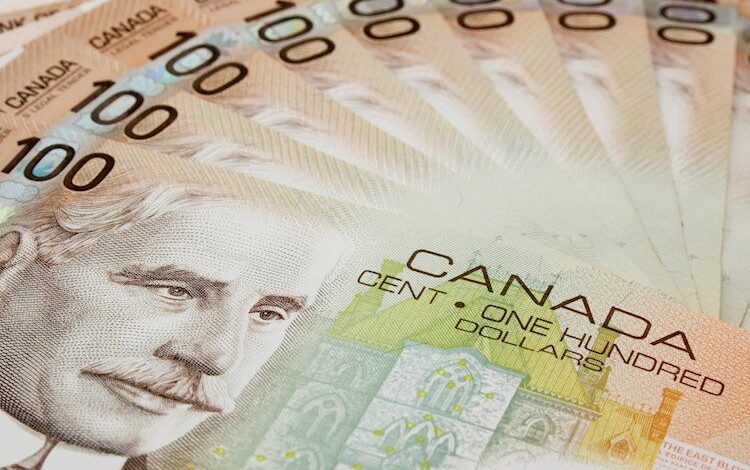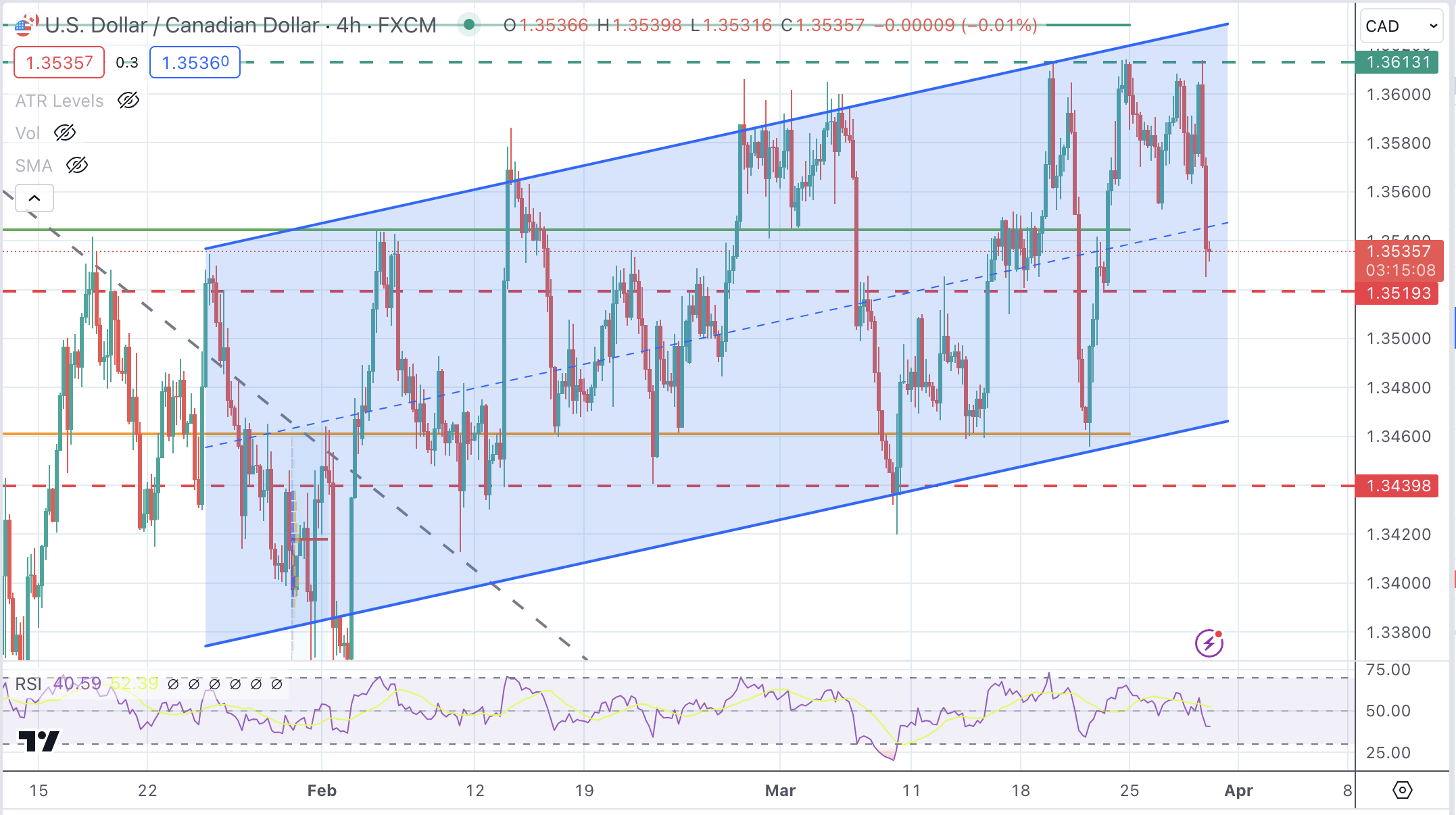Canadian Dollar rallies on upbeat GDP data and a softer USD

Canadian Dollar bounces up, fuelled by a bright Canadian GDP and a softer USD
NEWS |
|
By Guillermo Alcala
- Canadian Dollar is regaining lost ground after upbeat Canadian GDP data.
- US Dollar looks weak despite good US Jobless claims, upward revision of Q4 GDP.
- The focus is now on Friday’s PCE Prices Index and Fed Powell’s speech.
The Canadian Dollar (CAD) is trading higher for the fourth consecutive day on Thursday, yet with price action contained within previous ranges. Canada’s Gross Domestic Product bounced up strongly in January with preliminary estimations for February pointing to further economic expansion. These figures have restored confidence in Canada’s economic outlook, cooling off market expectations of imminent BoC rate cuts.
In The US, the larger-than-expected decline in US Weekly Jobless Claims and the upwardly revised Q4 Gross Domestic Product have been unable to provide a meaningful impact to the US Dollar. The Greenback is paring previous gains after having opened Thursday on a strong note, following hawkish remarks from Fed Governor Waller.
The US Dollar Index, which measures the value of the USD against a basket of the most traded currencies, is barely changed on the day after having whipsawed back and forth. Investors are czutious with all eyes on Friday’s US PCE Prices Index and a speech by Federal Reserve (Fed) Chair Jerome Powell at a monetary policy conference in San Francisco. Traders are looking for further clues about the central bank’s monetary policy plans.
Daily digest market movers: USD/CAD retreats as the Canadian economic outlook improves
- The Canadian Dollar is moderately bullish on its way to complete a four-day winning streak, favoured by upbeat Canadian data.
- Canadian GDP expanded at a 0.6% pace in January, beating expectations of 0.4% growth and following a 0.1% contraction in December.
- US Jobless Claims declined to 210K in the week of March 22 from 212K in the previous week against market expectations of an increase to 215K.
- Continuous Jobless claims have increased to 1.189M from 1.795M in the previous week, offsetting the impact of the upbeat headline reading.
- The final reading of the Q4 US GDP has been revised to a 3.4% growth from the 3.2% expansion previously estimated.
- Futures markets are pricing a 55% chance that the Fed will start cutting rates in June, down from levels above 60% on Wednesday, CME Group FedWatch Tool shows.
- Fed Governor Christopher Waller warned that there is no rush to start cutting rates, which has poured some cold water on the market consensus of three rate cuts in 2024.
- The highlight of the week is that the core PCE Prices Index is expected to have risen at a 2.8% yearly pace and 0.4% on the monthly rate in February, from 2.8% and 0.3%, respectively, in January.
Canadian Dollar price today
The table below shows the percentage change of Canadian Dollar (CAD) against listed major currencies today. Canadian Dollar was the weakest against the .
| USD | EUR | GBP | CAD | AUD | JPY | NZD | CHF | |
| USD | 0.15% | -0.08% | -0.41% | 0.08% | 0.06% | 0.21% | -0.50% | |
| EUR | -0.15% | -0.23% | -0.54% | -0.09% | -0.10% | 0.05% | -0.65% | |
| GBP | 0.07% | 0.22% | -0.32% | 0.15% | 0.15% | 0.28% | -0.42% | |
| CAD | 0.37% | 0.52% | 0.30% | 0.45% | 0.43% | 0.58% | -0.12% | |
| AUD | -0.08% | 0.07% | -0.13% | -0.47% | 0.01% | 0.13% | -0.57% | |
| JPY | -0.06% | 0.10% | -0.13% | -0.41% | 0.03% | 0.14% | -0.54% | |
| NZD | -0.21% | -0.05% | -0.29% | -0.60% | -0.12% | -0.11% | -0.69% | |
| CHF | 0.48% | 0.63% | 0.41% | 0.11% | 0.55% | 0.54% | 0.70% |
The heat map shows percentage changes of major currencies against each other. The base currency is picked from the left column, while the quote currency is picked from the top row. For example, if you pick the Euro from the left column and move along the horizontal line to the Japanese Yen, the percentage change displayed in the box will represent EUR (base)/JPY (quote).
Technical analysis: The USD is under increasing bearish pressure, heading to 1.3520
The USD/CAD is under increasing bearish traction after having been rejected at 1.3610 on its way to 1.3520 support area. The RSI has dipped below the 50 level, which suggests that sellers are in control.
The broader picture is still moderately positive, with the pair trading within a slightly bullish channel. A break of 1.3460 would negate this view. On the upside, resistance levels are 1.3615 and 1.3630.
USD/CAD 4-Hour Chart
The key factors driving the Canadian Dollar (CAD) are the level of interest rates set by the Bank of Canada (BoC), the price of Oil, Canada’s largest export, the health of its economy, inflation and the Trade Balance, which is the difference between the value of Canada’s exports versus its imports. Other factors include market sentiment – whether investors are taking on more risky assets (risk-on) or seeking safe-havens (risk-off) – with risk-on being CAD-positive. As its largest trading partner, the health of the US economy is also a key factor influencing the Canadian Dollar.
The Bank of Canada (BoC) has a significant influence on the Canadian Dollar by setting the level of interest rates that banks can lend to one another. This influences the level of interest rates for everyone. The main goal of the BoC is to maintain inflation at 1-3% by adjusting interest rates up or down. Relatively higher interest rates tend to be positive for the CAD. The Bank of Canada can also use quantitative easing and tightening to influence credit conditions, with the former CAD-negative and the latter CAD-positive.
The price of Oil is a key factor impacting the value of the Canadian Dollar. Petroleum is Canada’s biggest export, so Oil price tends to have an immediate impact on the CAD value. Generally, if Oil price rises CAD also goes up, as aggregate demand for the currency increases. The opposite is the case if the price of Oil falls. Higher Oil prices also tend to result in a greater likelihood of a positive Trade Balance, which is also supportive of the CAD.
While inflation had always traditionally been thought of as a negative factor for a currency since it lowers the value of money, the opposite has actually been the case in modern times with the relaxation of cross-border capital controls. Higher inflation tends to lead central banks to put up interest rates which attracts more capital inflows from global investors seeking a lucrative place to keep their money. This increases demand for the local currency, which in Canada’s case is the Canadian Dollar.
Macroeconomic data releases gauge the health of the economy and can have an impact on the Canadian Dollar. Indicators such as GDP, Manufacturing and Services PMIs, employment, and consumer sentiment surveys can all influence the direction of the CAD. A strong economy is good for the Canadian Dollar. Not only does it attract more foreign investment but it may encourage the Bank of Canada to put up interest rates, leading to a stronger currency. If economic data is weak, however, the CAD is likely to fall.
Information on these pages contains forward-looking statements that involve risks and uncertainties. Markets and instruments profiled on this page are for informational purposes only and should not in any way come across as a recommendation to buy or sell in these assets. You should do your own thorough research before making any investment decisions. FXStreet does not in any way guarantee that this information is free from mistakes, errors, or material misstatements. It also does not guarantee that this information is of a timely nature. Investing in Open Markets involves a great deal of risk, including the loss of all or a portion of your investment, as well as emotional distress. All risks, losses and costs associated with investing, including total loss of principal, are your responsibility. The views and opinions expressed in this article are those of the authors and do not necessarily reflect the official policy or position of FXStreet nor its advertisers. The author will not be held responsible for information that is found at the end of links posted on this page.
If not otherwise explicitly mentioned in the body of the article, at the time of writing, the author has no position in any stock mentioned in this article and no business relationship with any company mentioned. The author has not received compensation for writing this article, other than from FXStreet.
FXStreet and the author do not provide personalized recommendations. The author makes no representations as to the accuracy, completeness, or suitability of this information. FXStreet and the author will not be liable for any errors, omissions or any losses, injuries or damages arising from this information and its display or use. Errors and omissions excepted.
The author and FXStreet are not registered investment advisors and nothing in this article is intended to be investment advice.
Recommended content
Editors’ Picks
GBP/USD extends sideways grind above 1.2600
GBP/USD fluctuates in a narrow channel above 1.2600 on Thursday. The better-than-expected Initial Jobless Claims data from the US and the upward revision to the Q4 GDP growth help the USD stay resilient against its rivals and limits the pair’s upside.
Gold pulls away from daily highs, holds above $2,200
Gold retreats from daily highs but holds comfortably above $2,200 in the American session on Thursday. The benchmark 10-year US Treasury bond yield stays near 4.2% after upbeat US data and makes it difficult for XAU/USD to gather further bullish momentum.






